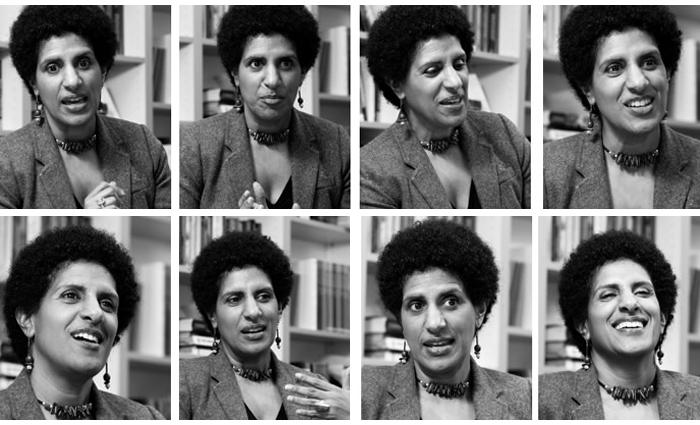Patricia Moonsammy

Patricia Moonsammy
Focus on Faculty
by Christine Baksi
Are there elements of your former corporate career that inspire your scholarly interests and teaching?
My scholarly interests and teaching are inspired primarily by my personal history as a first-generation American of Caribbean ancestry, but also have been shaped by my experiences working in the music industry and in university administration. As a teenager, I had the transformative experience of living in Trinidad for a few years. I was immersed in the vibrant culture of an incredibly rich, multiethnic, newly independent society. Elements of my experiences in the Caribbean would later become important threads in my scholarship and my teaching of expressive culture, music, performance, interethnic relations, postcolonialism and diaspora.
After college, I had the opportunity to work on the business side of the performing arts world with the University of California Berkeley’s Cal Performances, and later with Horizon Records, which at that time was the newly established World Music division of A&M Records. This was an interesting historical period when the circulation and consumption of primarily non-Western music was informing youth culture, social interactions, fashions and self-representations. Witnessing and working within the politics and business of the performing arts and music industries began to lay the foundation for my current interest in the political economy of music and the significance of media in society and culture.
Calypso, and rapso—its contemporary iteration—are genres you study closely in the context of expressive culture and performance art. What does the music tell us about the culture and politics of the Caribbean?
Calypso is a music that documents the histories and ideologies of the people who create it and the societies in which they live. Many calypsonians note that the music functions as a newspaper, conveying contemporary stories of local and global significance, attitudes about life and society, critiques of structures of power and the dreams and aspirations of its people. Rapso is an overtly political and activist variant of calypso, with deep roots in the oral traditions of the people of Trinidad and Tobago.
Although Trinidad and Tobago became independent of British colonial rule in 1962, the struggle for freedom and independence is ongoing. Through their music and performance, rapso artists advocate for economic and social justice and cultural self-determination. An important aspect of their work is to foster local pride while being simultaneously in conversation with regional and international social movements for human rights. What does this tell us about the culture and politics of the Caribbean? It tells us that the project to achieve independence continues and that artists are engaged in a critical assessment of their reality within the global dynamics of power and culture. Despite the history of genocide, slavery, colonialism, and neo-imperialism, Caribbean people have survived very difficult circumstances, using creativity and wit to manage the most difficult of experiences. The arts have been, and continue to be, a central feature of Caribbean political and social action.
As an anthropologist, how will you approach oral-history projects like your forthcoming work on interethnic relations in Trinidad and Tobago?
I’ll be employing a range of ethnographic methods to explore the experience and representation of what is locally referred to as “dougla”—the offspring of African and South Asian Indian unions and the resultant hybrid cultural forms that are an outcome of these mixtures. Through analyses of oral-history narrations, performances, and artifacts (family photos, music videos, street signs, advertisements, cookbooks), I will trace the Afro/Indo border crossings that have been an integral part of the socio-cultural evolution of Trinidad and Tobago. This project aims to uncover the interconnections between the experiences of dougla families, the history of the neighborhood of St. James (what has been referred to as the “dougla capital” of Trinidad), popular representations of mixture through mass media, and the integration of people through food practices.
Exciting plans are under way for a spring 2015 Mosaic during Trinidad’s annual Carnival. What will students learn and experience?
Jerry Philogene, assistant professor of American studies, and I are combining expertise in Caribbean societies, visual culture and performance to develop a mosaic that will explore Caribbean identities and performativities in ethnicity and race, gender, sexual orientation and religion. Another key aspect of this mosaic will be an examination of sustainability and the environment in art production, activist politics, cultural production, and as a historical response to limited resources. It is important that students walk away with a much more sophisticated understanding of the region and the role of expressive culture in the historical past and the contemporary period. Many people think of the Caribbean as a tourist destination, focusing on the landscape rather than the people, or alternatively, as the site of extreme poverty, disaster or corruption. We want to disrupt these narratives of the region. We have chosen Trinidad and Tobago as the site for this mosaic because the two islands encompass two ends of the spectrum of economic development. Trinidad is an industrialized and wealthy island with natural resources in gas, oil and minerals, while Tobago is largely agricultural with a significant tourist economy. The demographic complexity of the population, the rich artistic traditions that are most visible during the pre-Lenten annual Carnival but which exist year round, and the educational and cultural resources available in this nation make it eminently suitable for a study of Caribbean expressive culture.
Suggested reading
Jeff Henry, Under the Mas’: Resistance and Rebellion in the Trinidad Masquerade. San Juan, Trinidad: Lexicon Trinidad Limited, 2008.Christine G.T. Ho and Keith Nurse (eds.), Globalisation, Diaspora and Caribbean Popular Culture. Kingston and Miami: Ian Randle Publishers, 2005.
Tejaswini Naranjana, Mobilizing India: Women, Music and Migration between India and Trinidad. Durham: Duke University Press, 2006.
Gordon Rohlehr, A Scuffling of Islands: Essays on Calypso. San Juan, Trinidad: Lexicon Trinidad Ltd., 2004.
Photos by Carl Socolow '77
Published September 24, 2013